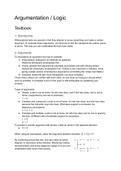Argumentation / Logic
Textbook:
1: Standpoints
Philosophical texts are special in that they attempt to prove something and make a certain
argument. To evaluate these arguments, one first has to find the standpoint the author wants
to prove. This way you can understand the text more easily.
2: Arguments
To reconstruct an argument one has to consider:
1) interpretation (interpret it as faithfully as possible)
Historical philosophy emphasises this.
2) charity (present the argument as plausible as possible and add missing steps)
Systematic philosophy emphasises this. Charity is also important in debates, since
giving a weak version of someone’s argument is committing the “straw man fallacy”.
3) simplicity (make the text more transparent, not more complex).
These three criteria can conflict with each other, so one ends up having to choose which
ones to prioritise. A complete score on the exam is still achievable by explaining your
choices.
Types of arguments:
● Simple: Linda is not at home, for she has class, and if she has class, she is not at
home. (supported by one set of premises)
1 -> 2
● Complex and compound: Linda is not at home, for she has class, and she has class
because the instructor says she does. (Premises support a conclusion via
steps/sub-conclusions)
1 -> 2 -> 3
● Complex and multiple: Linda is not at home, for she has class and no one is opening
the door. (Different sets of premises support a conclusion)
1 -> 3
2 ----^
To present a counter argument with arrows, make an arrow in the opposite direction.
● 3 <- 5
When using an assumption, place the argument between brackets: [1 -> ⅔] -> 4
By combining arrows like this, one can make an arrow
diagram to reproduce entire debates. Mastering making
reconstructions and arrow diagrams makes it so you can
understand texts much more quickly.
,3: Reading
Framed reading vs unbiased reading: Framed reading is to read a text with a certain
discussion in mind so the text can be placed in there. This can help one read the text, but
can also make one biased about it.
4: Validity
An argument is valid if the conclusion follows from the premises, regardless of whether the
premises are true or not. Meanwhile an argument is sound if it is valid and the premises are
true (or at least plausible.
Discussion can also concern this; we don’t always know whether premises are true, but we
can determine if certain conclusions follow if they were true (but there are still valid
arguments with a false conclusion).
An argument form consists of a set of lines where each line is a premise. The letters ‘p’ and
‘q’ represent propositions.
Logically valid argument forms:
● Modus ponens
1: If p, then q premise
2: p premise
3: Therefore: q from 1, 2
For example:
(1) If Socrates is a human being, then Socrates is mortal.
(2) Socrates is a human being.
(3) Therefore: Socrates is mortal
(If one were to reverse q and p, it becomes an ‘affirmation of the consequent’, which
is always invalid.)
● Modus tollens
1: If p, then q premise
2: Not-q premise
3: Therefore: not-p from 1, 2
For example:
(1) Consequentialism condemns an individual act A only if A makes a difference.
(2) A makes no difference in collective action cases.
(3) Therefore: consequentialism cannot condemn A in such situations.
(Again, if one were to reverse q and p, it becomes an ‘affirmation of the consequent’,
which is always invalid.)
‘One person’s modus ponens is another’s modus tollens’: One can deny a conclusion and
turn an argument from a modus ponens in a modus tollens.
1) If you can act against famine by giving substantially, and you don’t have to sacrifice a
comparable moral importance by doing so, then you must give substantially.
2) You can act against famine in the world by giving substantially, and you don’t have to
sacrifice anything of comparable moral importance.
3) Therefore: you have to give substantiality.
, Becomes:
1) If you can act against famine by giving substantially, and you don’t have to
sacrifice a comparable moral importance by doing so, then you must give
substantially.
2) You don’t have to give substantially.
3) Therefore: it is not the case that you can act against famine by giving substantially
or not the case that you thereby do not have to sacrifice anything of comparable
moral importance.
Note that you then still need to show how the (2) in your modus tollens is more plausible
than the (2) in the modus ponens.
● Disjunctive Syllogism
1: p or q premise
2: Not-p premise
3: Therefore: q from 1, 2
For example:
(1) The solution to the collective action problem is either consequentialism or
deontology.
(2) Consequentialism is not a solution.
(3) Therefore, deontology is the solution.
● Dilemma
1: p or q premise
2: If p, then r premise
3: If q, then r premise
4: Therefore: r from 1, 2, 3
For example:
(1) Either consequentialism or deontology is correct.
(2) If consequentialism is correct, then slavery is morally wrong.
(3) If deontology is correct, then slavery is morally wrong.
(4) Therefore: slavery is morally wrong.
(The dilemma is called false if (1) is false)
● Conditional proof
1: p Assumption
2: q from 1 (with additional premises)
3: Therefore: if p, then q from 1, 2
For example:
(1) Determinism is true.
(2) I am not responsible for my deeds.
(3) Therefore: if determinism is true, then I am not responsible for my deeds.




